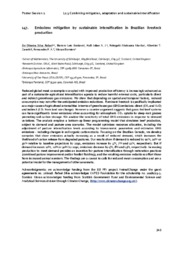Emissions mitigation by sustainable intensification in Brazilian livestock production.
Emissions mitigation by sustainable intensification in Brazilian livestock production.
Author(s): SILVA, R. O.; BARIONI, L. G.; HALL, J. A. J.; MATSUURA, M. I. da S. F.; ALBERTINI, T. Z.; FERNANDES, F. A.; MORAN, D.
Summary: Reduced global meat consumption coupled with improved production efficiency is increasingly advanced as part of a sustainable agricultural intensification agenda to reduce harmful external costs, particularly direct and indirect greenhouse gas emissions. We show that depending on spatial and temporal factors, reduced consumption may not offer the anticipated emission reductions. Ruminant livestock is specifically implicated as a major cause of agricultural externalities in terms of greenhouse gas (GHG) emissions: direct (CH4 and N2O) and indirect (CO2 from land use change). However a counter-argument suggests that grass-fed beef systems can have significantly lower emissions when accounting for atmospheric CO2 uptake by deep-root grasses promoting soil carbon storage. We analyse the sensitivity of total GHG emissions in response to demand variations. The analysis employs a bottom-up linear programming model that simulates beef production, subject to demand and pasture area scenarios. The model optimises resources allocation, including the adjustment of pasture intensification levels according to bioeconomic parameters and estimates GHG emissions - including changes in soil organic carbon stocks. Focusing on the Brazilian Cerrado, we develop scenarios that show emissions actually increasing as a result of reduced demand, which increases the likelihood of carbon release from degraded pastures. Our results show if demand is reduced by 10%, 20% or 30% relative to baseline projections by 2030, emissions increase by 4%, 7% and 12%, respectively. But if demand increases 10%, 20% or 30% by 2030, emissions decrease by 5%, 8% and 13%, respectively. Increasing production to meet demand provides an incentive for pasture intensification through restoration practices (combined pasture improvement and/or feedlot finishing), and the resulting emission reductions offset those from increased animal numbers. The findings are a caveat to calls for reduced meat consumption and are a potential model for the management of other savannahs
Publication year: 2015
Types of publication: Abstract in annals or event proceedings
Unit: Embrapa Environment
Keywords: Emissions, Mitigation
Observation
Some of Embrapa's publications are published as ePub files. To read them, use or download one of the following free software options to your computer or mobile device. Android: Google Play Books; IOS: iBooks; Windows and Linux: Calibre.
Access other publications
Access the Agricultural Research Database (BDPA) to consult Embrapa's full library collection and records.
Visit Embrapa Bookstore to purchase books and other publications sold by Embrapa.

